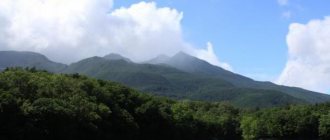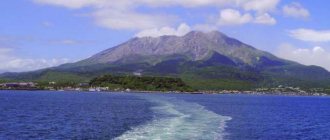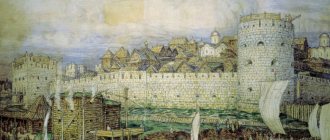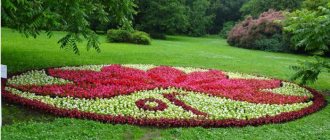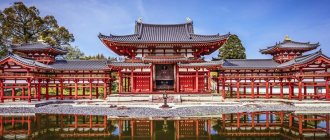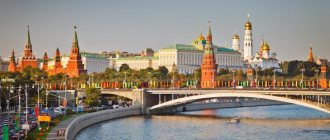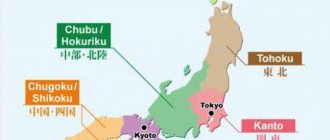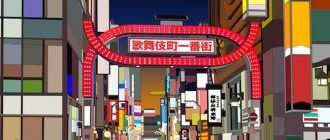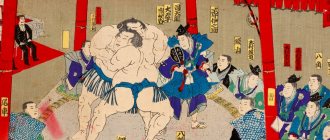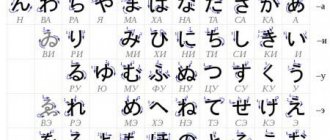Noodles and a handful of maple leaves
Shikoku, Japan's fourth largest island, has 800 noodle shops and is the birthplace of udon. Traditional wheat noodles in broth - Sanuki udon, in unremarkable establishments, are served in wooden tubs - one is taken per family. The noodles are eaten with unaesthetic noise, sucking on them with the lips. A trip to a regular noodle shop in Shikoku is a great social and gastronomic experiment. Here visitors will complain about you if you look at those around you too intrusively and even if you pick up a camera.
And if, nevertheless, you were not asked to leave the establishment, the locals will look at you sternly and unfriendly from under the noodles. At the same time, complete bewilderment at your presence will be read on their faces. The noodles taste a little bland, and you want to splash a mug of soy sauce into the bowl. However, you always have to get used to new tastes in Japan.
- Orange fact Shikoku Island is the fiftieth largest in the world
I don’t know if it’s worth going to Shikoku just for the iconic udon, but it’s interesting to see another side of Japan. Only 4% of the country's population lives in Shikoku, which is approximately 4 million people, so different from the capital's fashionable urbanists and hysterical office workers. You won’t find hipsters or cosplayers here, and there are almost no white-collar workers, decorously going to work in offices. It seems that there are no offices either - in the large cities of the island of Takamatsu and Tokushima there are practically no high-rise buildings.
This is some kind of low-rise Japan, with blooming citrus sudachi gardens behind fences, wooden houses and the tranquility of the outback. The Japanese themselves come to Shikoku for the most part with two purposes: either to make a religious pilgrimage to the 88 temples of the island, or to admire the red maples in one of the oldest landscape parks in the country, Ritsurin.
Ritsurin Park
The 75-hectare gardening farm was established in Takamatsu more than 350 years ago. Everything is arranged and planted in strict accordance with the instructions of Japanese gardens, so that at every new turn, from every curved bridge, a new landscape appears before your eyes and the angle of view changes. The best time to accept the idea of landscape designers is autumn, however, cherry blossoms also bloom in spring. Surely the name of the founder of the garden from the Ikomo clan will not tell you anything, nor will a detailed listing of the metrics of the family from the Matsudairo dynasty, which later looked after the Ritsurin park.
It took a hundred years for the gardens, 13 hills and Mount Hirai - the Mount of the Immortals, symbolizing Fuji - to look perfect. The Japanese were terrible perfectionists even three hundred years ago. Therefore, visitors should also ideally walk around Ritsurin, slowly, with stops, sitting on benches, renting a boat. With an obligatory tea ceremony in a house near the Kikugetsu-tei pond - “a gazebo for enjoying the beauty of the full moon in autumn.” You definitely need to get to the other side of the six ponds, where falcons hunt on a fine day.
- Orange fact In a Japanese traditional garden, Japanese sakura, maples and pine trees must certainly grow. Be sure to have a pond with koi carp, a tea house, a rock garden, a gazebo with wisteria and lanterns, into which fish oil used to be poured, a wick inserted and set on fire. The water should not only be silent and silent, like a pond, but also speak two languages - a stream and a waterfall.
You need to admire the landscapes meaningfully - the heart should rest in a Japanese garden. If you look at the Mountain of the Immortals, then you yourself are also approaching immortality. Studying the details on Turtle Island, you think about longevity. If you come across koi carp, which can sooner or later, according to legend, turn into a dragon, thoughts about fortitude should appear. Finally, you need to go to the bonsai garden; Kagawa Prefecture is famous for them, and especially for dwarf pines. Many trees are more than three hundred years old.
- Opening hours of Ritsurin Koen Prak: January: from 7:00 to 17:00 February: from 7:00 to 17:30 March: from 6:30 to 18:00 April and May: from 5:30 to 18:30 June -August: from 5:30 to 19:00 September from 5:30 to 18:30 October: from 6:00 to 17:30 November: from 6:30 to 17:00 December: from 7:00 to 17:30
- Ticket price: 400 yen
- How to get there: From JR Takamatsu Station, take the commuter train to Ritsurinkoen-Kitaguchi Station (5 minutes). 5 minutes walk from the station.
Story
In ancient times, the island was called Iyo-no-futana-shima (Japanese: 伊予之二名島), Iyo-shima (Japanese: 伊予島) and Futana-shima (Japanese: 二名島). The modern name reflects the fact that there were four historical regions on the island - Awa, Iyo, Sanuki and Tosa.
As a result of the administrative reform of 1871-1876, Tosa, Awa, Sanuki and Iyo were transformed into Kochi, Tokushima, Kagawa and Ehime prefectures, respectively.
Shikoku has long been known for its 88 pilgrimage temples, which are associated with the activities of the semi-legendary Buddhist monk Kukai.
Naruto Whirlpools
The Japanese love to view this unique natural phenomenon from all sides. First from above - from the glass-floored walkway Uzo-no-Michi, which is installed under the Onaruto Bridge, from a height of 40 meters. Then from the shore, from the Senjojiki Observatory building, not far from the whirlpools. And in the climactic conclusion - under water, enjoying the bubbles swirling in a vortex behind the ship's portholes. The latter is the best way to lose orientation and lose the battle with your own vestibular apparatus. The full sensation of getting inside the washing machine in the “Spin” mode is guaranteed. The main thing is to crawl down onto the pier like a jellyfish at the end of the walk and smile politely - I really liked it!
Whirlpools form in the narrow bay of the Seto Inland Sea between the islands of Shikoku and Awaji, into which the Pacific Ocean is trying to penetrate with all its power. It is believed to be the fourth strongest tidal current in the world, with a water level difference of 1.5 meters. Craters, which sometimes form up to 20 meters in diameter, appear, swirl at a speed of 20 km/h, disappear and form again. The natural spectacle usually occurs every six hours, according to the schedule of the moon and the tides. The best time to observe is in the early morning or afternoon, during the new and full moon, in spring and autumn.
- How to get to the whirlpools: From Tokushima Station, take the train to Naruto Station. then transfer to the Naruto Narutokoen-iki bus, which will take you to Naruto Koen in 30 minutes. Entrance fee to the bridge is 510 yen.
- Opening hours: from 9:00 to 18:00 (from 9:00 to 17:00 from October to February)
- Closed: every second Monday (June, September, December March)
- Boat ride - from 1500 yen.
- The appearance of whirlpools is predicted with great accuracy; it is better to find out the time on the website. www.uzusio.com
Climate
Due to its length from north to south, the climatic conditions of Japan differ in different parts of the country. Hokkaido has cold temperatures. The islands in the southwestern part, on the contrary, have warm conditions, as a subtropical climate has formed here.
Winters in Hokkaido are colder than in other regions of Japan; snow on the island occurs up to 120 days per season. On the mountain ranges closer to the northern part of the island, snowdrifts can reach 11 meters, and almost two meters off the Pacific coast. In January the average temperature is from -12 to -4 degrees. Throughout the winter, many drifting ice floes are observed from the Sea of Okhotsk.
Summers are usually cool too. The average August temperature is from 17 to 22 degrees. In summer, the number of rainy days on average reaches 150, although on other islands this figure is much higher.
Dinner at the samurai's house
Unfortunately, the valiant samurai, who so loved to leave gracefully from this mortal world, can no longer be found in Japan. But their ancestors still have family stories to tell. True, in Japanese. From the story with some English words, with subtle gestures and demonstrations of engravings, it was possible to understand that the excellent Go-Yashiki restaurant was opened in the real home of a samurai, holder of the title “Yoriki”. His family lived here for almost 250 years. Hanzaburo Yoshikatsu carried the samurai longsword and was in charge of the judicial system, serving Lord Takamatsu. His great-great-great granddaughter opened a restaurant in the family home, where, despite her respectful years, she herself serves the dishes that her ancestor loved to visitors. I spent the evening in her house with a Japanese garden and I can honestly say that this shabu-shabu dinner was one of the most delicious in Japan. I simmered shiitake, crab, vegetables and fish in boiling dashi broth. In addition, the entire table was filled with all sorts of snacks, pickles, noodles and the obligatory miso soup.
Food in Shikoku
- Sanuki udon in Kagawa is a fairly thick and elastic noodle made from wheat flour, salt and water. Serve it with sauce or in a hot broth with toppings such as bonito flakes, sesame seeds, grated daikon radish and chopped green onions.
- Tokushima ramen is made with pork bone broth and vegetables. Served with wheat noodles, eggs, pork ribs or chicken, green onions and sweet sauce.
- Katsuo no tataki at Kochi is a dish of tuna that is wrapped in straw and left to rest until golden brown, then sliced and served with ginger, garlic, shiso leaves, leeks and ponzu (citrus sauce with added soy sauce) ).
- Botchan dango is a traditional Japanese dessert in Ehime. Consists of three mochi (rice cakes) on a bamboo stick, each with a different flavor: green tea, egg and bean paste.
- Imotaki in Ehime is a fall dish with taro root, chicken and fried tofu. It is believed that this dish is best eaten on the river bank in nature.
Fugu Restaurants
Perhaps, given its historical background in Japanese gastronomy, fugu fish is the strangest food of the islands. Pufferfish are known to be poisonous. So much so that the tiniest dose of poison can color the evening with amazing sensations and wonderful euphoria, and a slightly larger dose will send the gourmet to his forefathers, and together with the cook, who, according to tradition, must make himself hara-kiri if the client gave his soul to God while eating fugu fish. Now everything is much more prosaic, pufferfish are grown on farms where they are not allowed to eat any bottom debris that settles in the silt and turns into toxic molecules of tetrodotoxin poison in the internal organs of the pufferfish.
There are several fugu restaurants in Takamatsu; they serve exclusively fugu - fresh in the form of sashimi - fugusashi, boiled fugu-zosui, deep-fried and dozens of other options, but be that as it may, to be honest it is not tasty. To cut fugu, the cook needs to obtain a special license. You can try Japanese “Gourmet Roulette” in one of the Takamatsu restaurants. However, you still bring the fugu sashimi with chopsticks to your mouth with a trembling hand and scold yourself for the fact that some adventures can, in theory, end very badly. And yes, there is no antidote. I recommend the nerve-wracking restaurant Hyakutora.
- Orange fact Puffer fish can swim tail first. If the puffer is frightened, it takes the form of a ball with sharp spines. Pufferfish venom is 1200 times more dangerous than potassium cyanide. The lethal dose is only 1 milligram, so the poison of one puffer fish can kill 40 people.
Other things to do in Shikoku:
- Take a walk along Chuo-Dori Street, which starts from Takamatsu Port
- Spend a day on Naoshima Museum Island
- Visit Honen-ji Temple
- Visit the museum of garden art by sculptor Isamu Noguchi
- See the Yashima lava plateau, 293 meters high
- Get to the themed ethnographic village "Shikoku Mura"
- Bask in the hot springs in the 1300-year-old village of Shionoe-onsen-kyo or relax in Dogo-onsen.
- Watch bloodless bullfights in Uwajima
The three most famous festivals in Shikoku are:
- Awa Odori Festival in Tokushima. More than a million people gather on the streets of Tokushima, professionals and amateurs in traditional costumes demonstrate different types of traditional Japanese dances.
- Yosakoi Festival in Kochi. Another dance festival in Shikoku. The special program of the festival is a clapping dance, which in ancient times was used to scare away dangerous birds.
- Taiko festival in Ehime. The city of Niihama hosts a parade of portable dashi shrines of various shapes and colors. A very beautiful sight.
How to get to Shikoku:
The islands of Honshu and Shikoku are connected by a bridge that was built in 1988. However, it is more convenient to travel by air: it takes 1 hour and 10 minutes from Haneda Airport in Tokyo to Takamatsu.
Or by train: 3 hours 20 minutes from Tokyo to Okayama Station on the JR Tokaido-Sanyo Shinkansen Line and 1 hour from Okayama Station to Takamatsu Station on the JR Seto-ohashi Line.
Tags:
Japan
And this is also interesting:
“Sea Maidens” - Pearl Fishers Visiting Ama Divers
Naoshima - the island of art The main art project of Japan
Onsens of Japan Consult sources
Islands of Japan
Konnichiwa, dear friends!
Today the topic of our conversation will be the Japanese islands.
Without a doubt, Japan is an island state. It has more than 3000 islands. Among them there are both large and many small ones scattered throughout the Pacific Ocean.
I would like to start, of course, with the largest ones. There are four of them: Honshu, Hokkaido, Kyushu and Shikoku.
There is a funny rhyme with which you can easily remember these names: Dear Hokkaido, I love you Honshu. For your Shikoku I love you Kyushu. I hope you smiled
The largest of the islands of Japan
Honshu is the largest in size of the four. It occupies about 60% of the entire territory of Japan. Previously, the island was called differently: Hondo, Nippon.
It is on the island of Honshu that the most famous and largest Japanese cities are located: Tokyo, Kyoto, Yokohama, Osaka. Also located here is Mount Fuji, widely known outside Japan. Mount Fuji is a symbol of both Japan and the religious life of the Japanese.
About 100,000,000 people live on the island.
The coldest island in Japan
Hokkaido is a much smaller island in comparison to Honshu both in size and in number of inhabitants - about 5,500,000 people live there.
Ancient names of Hokkaido: Ezo, Matsumae, Ieddo, Yesso. Famous cities on the island of Hokkaido are Sapporo, Wakkanai, Chitose.
An interesting fact is that Hokkaido has a rather harsh climate compared to the rest of the islands of Japan, and the Japanese themselves consider Hokkaido to be the “north”.
However, there are many beautiful places in Hokkaido. For example, Lake Shikotsu, which does not freeze in winter. Or the Furano district, where you can see huge fields of lavender and daffodils.
Tourists in Hokkaido are attracted by the many pristine natural landscapes and ski resorts. The most famous ski resort is Niseko on Mount Annupuri.
The island of Hokkaido is also famous for its local cuisine, which stands out for its cooking methods using numerous dairy products.
The most ancient island of Japan
Next, let's look at the next major island of Japan - Kyushu .
About 12,000,000 people live here. The following famous and large cities are located in Kyushu: Nagasaki, Kagoshima, Kumamoto, Hirado, Fukuoka.
It is believed that Japanese civilization originated on the island of Kyushu.
Unlike Hokkaido, Kyushu has a comfortable and warm climate. Hot spring resorts are also located here.
The city of Nagasaki is also interesting, where the Peace Park was built in memory of the Second World War and the atomic bomb dropped on the city.
The smallest of the major islands of Japan
The last of the large islands is Shikoku.
The population of this island is 4,000,000 people. The cities here are Matsuyama, Takamatsu, Kochi, Tokushima.
There are many pilgrimage temples on the island of Shikoku. This is what he is so famous for.
Recently, there has been a noticeable migration of young people from the island of Shikoku to the large cities of Honshu - Tokyo and Osaka. This results in a large percentage of elderly people on the island.
After we looked at the large Japanese islands, I wanted to turn to the smaller ones and talk about the most interesting of them.
The island located in the very east of Japan is Minamitori , translated from Japanese as Southern Bird Island. This island is very small, its area is only 1.2 kilometers square. Interestingly, almost no one lives on it. This is due to the lack of fresh water on the island. Mostly, military personnel and scientists study its geology on Minamitori Island.
The island is also visited by lovers of extreme sports and recreation.
Another unusual small Japanese island is Okunoshima , or “Rabbit Island”. Its name refers to the many wild animals that live here. There are especially many rabbits on the island, which are not at all afraid of people.
During World War II, a chemical weapons plant was located on Okunoshima. This was a strictly classified production, which is why the island was even removed from various maps. Now on the island the Museum of Toxic Substances reminds of that time.
There is a version that the huge number of rabbits is connected precisely with the testing of chemical weapons on them. Today, any visitor to the island can stay in a tourist hotel for sightseeing, as well as feed the rabbits.
There is an island on a volcano in Japan - Aogashima . Despite the present danger of an eruption, people here live comfortably and calmly. The nature here is incredibly beautiful, and the climate is very mild and warm.
So, we have briefly shared with you information about the most interesting and fascinating islands of Japan. A whole large article could be written about each of them, but that’s for next time.
You can start exploring mysterious Japan and learning Japanese now! Our main course, Japanese for beginners, will help you with this in three steps!
